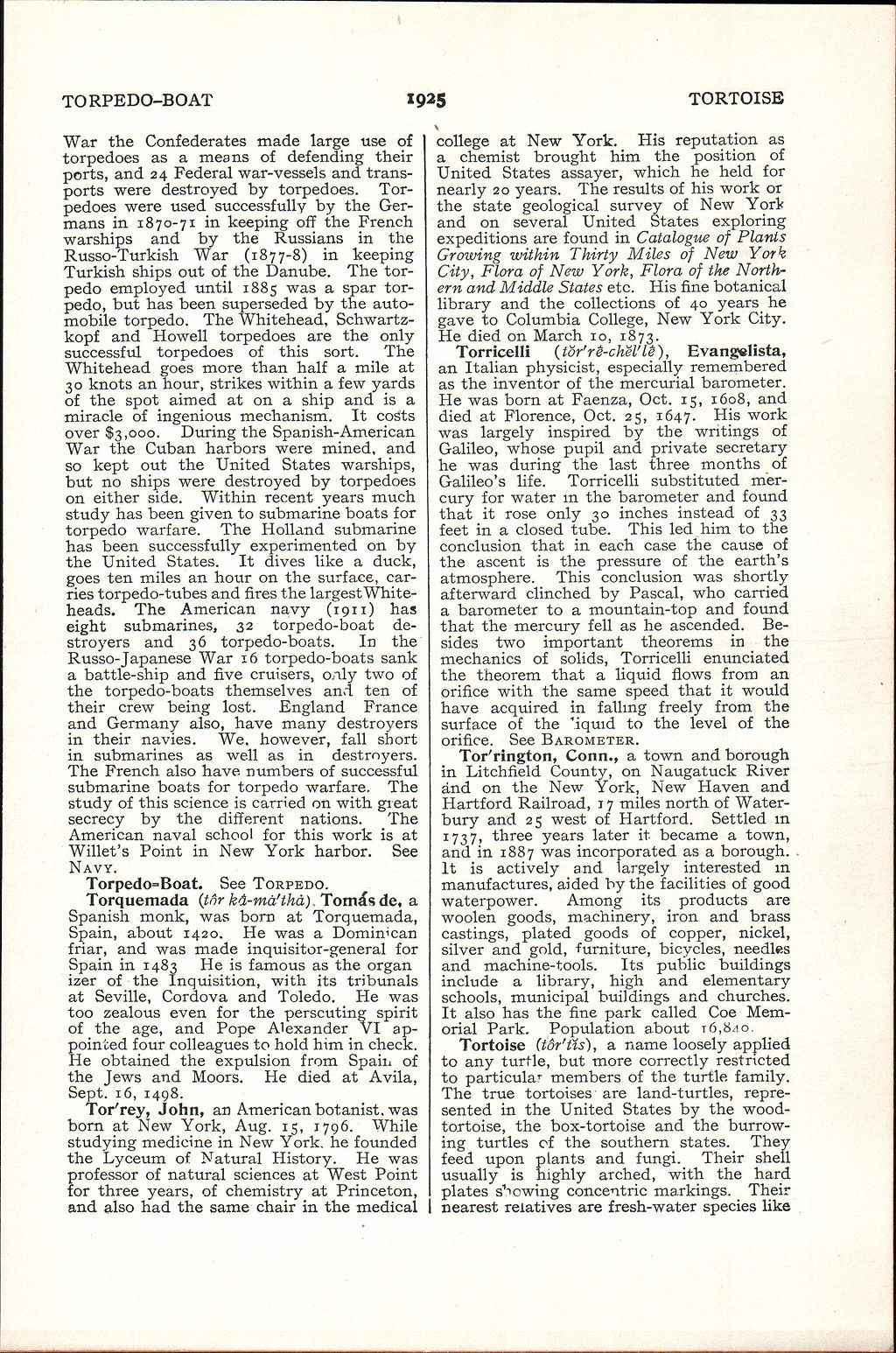TORPEDO-BOAT
1925
TORTOISE
War the Confederates made large use of torpedoes as a means of defending their ports, and 24 Federal war-vessels and transports were destroyed by torpedoes. Torpedoes were used successfully by the Germans in 1870-71 in keeping off the French warships and by the Russians in the Russp-Turkish War (1877-8) in keeping Turkish ships out of the Danube. The torpedo employed until 1885 was a spar torpedo, but has been superseded by the automobile torpedo. The Whitehead, Schwartz-kopf and Howell torpedoes are the only successful torpedoes of this sort. The Whitehead goes more than half a mile at 30 knots an hour, strikes within a few yards of the spot aimed at on a ship and is a miracle of ingenious mechanism. It costs over $3,000. During the Spanish-American War the Cuban harbors were mined, and so kept out the United States warships, but no ships were destroyed by torpedoes on either side. Within recent years much study has been given to submarine boats for torpedo warfare. The Holland submarine has been successfully experimented on by the United States. It dives like a duck, goes ten miles an hour on the surface, carries torpedo-tubes and fires the largest White-heads. The American navy (1911) has eight submarines, 32 torpedo-boat destroyers and 36 torpedo-boats. In the Russo-Japanese War 16 torpedo-boats sank a battle-ship and five cruisers, only two of the torpedo-boats themselves and ten of their crew being lost. England France and Germany also, have many destroyers in their navies. We, however, fall short in submarines as well as in destroyers. The French also have numbers of successful submarine boats for torpedo warfare. The study of this science is carried on with great secrecy by the different nations. The American naval school for this work is at Willet's Point in New York harbor. See NAVY.
Torpedo-Boat. See TORPEDO.
Torquemada (tor kd-ma'tkd), Toma*s de, a Spanish monk, was born at Torquemada, Spain, about 1420. He was a Dominican friar, and was made inquisitor-general for Spain in 1483 He is famous as the organ izer of the Inquisition, with its tribunals at Seville, Cordova and Toledo. He was too zealous even for the perscuting spirit of the age, and Pope Alexander VI appointed four colleagues to hold htm in check. He obtained the expulsion from Spain of the Jews and Moors. He died at Avila, Sept. 16, 1498.
Tor'rey, John, an American botanist, was born at New York, Aug. 15, 1796. While studying medicine in New York, he founded the Lyceum of Natural History. He was professor of natural sciences at West Point tor three years, of chemistry at Princeton, and also had the same chair in the medical
college at New York. His reputation as a chemist brought him the position of United States assayer, which he held for nearly 20 years. The results of his work or the state geological survey of New York and on several United States exploring expeditions are found in Catalogue of Plants Growing within Thirty Miles of New York City, Flora of New York, Flora of the Northern and Middle States etc. His fine botanical library and the collections of 40 years he gave to Columbia College, New York City. He died on March 10, 1873.
Torricelli (tbr're-chel'le), Evangelista, an Italian physicist, especially remembered as the inventor of the mercurial barometer. He was born at Faenza, Oct. 15, 1608, and died at Florence, Oct. 25, 1647. His work was largely inspired by the writings of Galileo, whose pupil and private secretary he was during the last three months of Galileo's life. Torricelli substituted mercury for water in the barometer and found that it rose only 30 inches instead of 33 feet in a closed tube. This led him to the conclusion that in each case the cause of the ascent is the pressure of the earth's atmosphere. This conclusion was shortly afterward clinched by Pascal, who carried a barometer to a mountain-top and found that the mercury fell as he ascended. Besides two important theorems in the mechanics of solids, Torricelli enunciated the theorem that a liquid flows from an orifice with the same speed that it would have acquired in falling freely from the surface of the "iquid to the level of the orifice. See BAROMETER.
Tor'rington, Conn., a town and borough in Litchfield County, on Naugatuck River and on the New York, New Haven and Hartford Railroad, 17 miles north of Water-bury and 25 west of Hartford. Settled in 1737, three years later it became a town, and in 1887 was incorporated as a borough. It is actively and largely interested in manufactures, aided by the facilities of good waterpower. Among its products are woolen goods, machinery, iron and brass castings, plated goods of copper, nickel, silver and gold, furniture, bicycles, needles and machine-tools. Its public buildings include a library, high and elementary schools, municipal buildings and churches. It also has the fine park called Coe Memorial Park. Population about 16,8/10.
Tortoise (tor'tis}, a name loosely applied to any turtle, but more correctly restricted to particular members of the turtle family. The true tortoises are land-turtles, represented in the United States by the wood-tortoise, the box-tortoise and the burrowing turtles of the southern states. They feed upon plants and fungi. Their shell usually is highly arched, with the hard plates showing concentric markings. Their nearest relatives are fresh-water species like
